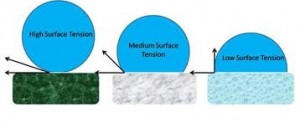Glassseal ( Glass Water Repellent )
Glass may look like a flat smooth surface; in actual fact it is far from it. When viewed under a microscope you would not recognize that you are looking at a glass surface. Having peaks and valleys it becomes a magnet for contamination, dirt and grime. This over time stains the glass in such a way that sometimes the how much you washed and scrubbed you could not get it to shine or look clear again. Well this is the deterioration glass goes through over time by the deposits In the water, dust and dirt. This is particularly noticeable in areas such as marine front properties, central metropolitan areas and even in shower enclosures inside your home. The glass quickly becomes opaque with the build up of dirt on it.
Hence there is clearly a need for a glass that is protected from these adverse effects of the environment. A glass that requires a lot less maintenance than regular glass. A glass that looks shiny and new and stays that way for a long time.
Let’s start with saying that the term “Self Cleaning” is a little misrepresentative in itself mainly in the expectations it might create, but Self Cleaning glass has become a trade term for many products out there in the market. One of the best technology available in the market is Glass coated or applied with hydrophilic layer that uses photocatalytic decomposition. Hydrophilic simply means that the glass will attract the water and make it spread out like a thin film.
this glass that is based on having a film of titanium dioxide coating. The glass works in two stages. The “photocatalytic” (simply meaning the accelerated process of using the ultraviolet light to break down the organic dirt on the glass) and makes the glass hydrophilic, During the following “hydrophilic” stage rain washes away the dirt, leaving almost no streaks, because hydrophilic glass spreads the water evenly over its surface.
Under the right conditions, meaning frequent sun and rain, or if hosed down regularly will reduce the cleaning cycle required of glass. The coating is stable and has a long life span.

A remarkable feature of photocatalysts is light induced ‘water-shedding’ or super hydrophilicity. In the presence of light the photocatalyst nano crystals of Colossus ® Glassseal actually act as a ‘wetting agent’ that helps water sheet off, instead of typical beading which leaves spots. The coating forms a very thin water film which easily runs off, taking dirt, oils and contaminants with it
The assumed mechanism of super hydrophilicity is novel, yet simple: the light activated coating reduces the contact angle of water on its surface.

The photocatalyst coating does not repel water so water cannot exist in the shape of a drop. Instead, water spreads flatly on the surface and sheets off with the Colossus ® Glassseal coating acting as a surfactant.Benefits of hydrophilicity include less spotting, ease of dirt release and oil removal (the applied Colossus ® Glassseal coating is oleophobic), reduction in cleaning costs and faster evaporation. In conjunction with Colossus ® Glassseal photo-oxidation of organic dirt and microbes, all contaminants are also more easily washed off. Oils, including most exhaust products, can easily be removed. A simple rainfall or water wash is effective because the treated surface has a greater affinity for the water than the oil
Importantly, Colossus ® Glassseal on a surface also increases heat transfer. For xample, on metals, such as evaporators in air conditioning systems, the hydrophilic coating will exhibit superior heat transfer performance by inducing film flow (and evaporation) versus the larger sessile droplets on an untreated surface. In general, the thin film provides greater heat transfer than the comparatively large drops, promoting more of the desired evaporative effect. Additionally, dynamic simulations of heat flow show significant heat transfer enhancement due to the increased surface area of a nano structured surface. For general applications of Colossus ® Glassseal , the combination of organic decomposition and the water-release effect of contaminants add to the self-cleaning aspect of our coating. On exteriors, windows require less cleaning and building exteriors shed dirt and grime more easily, providing a more attractive appearance, requiring lower maintenance
